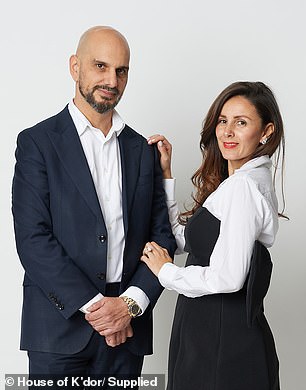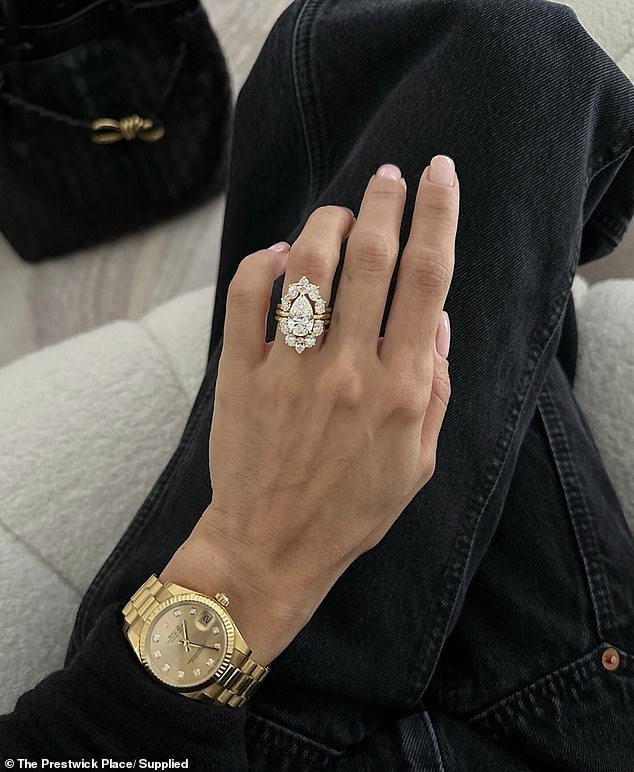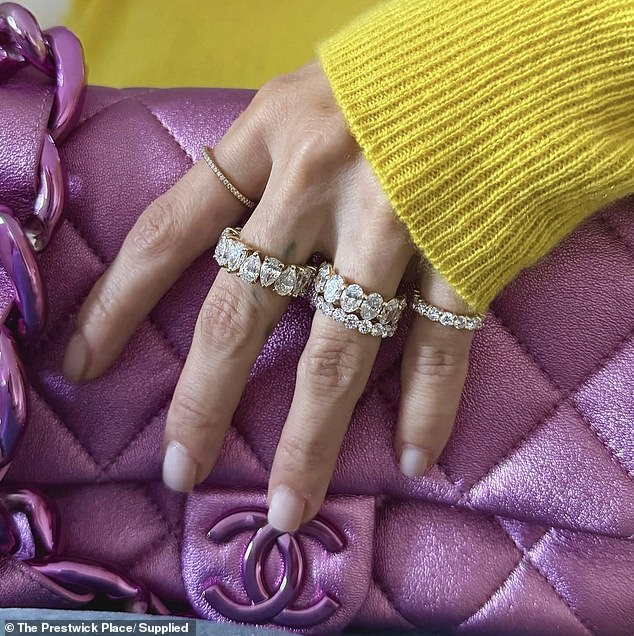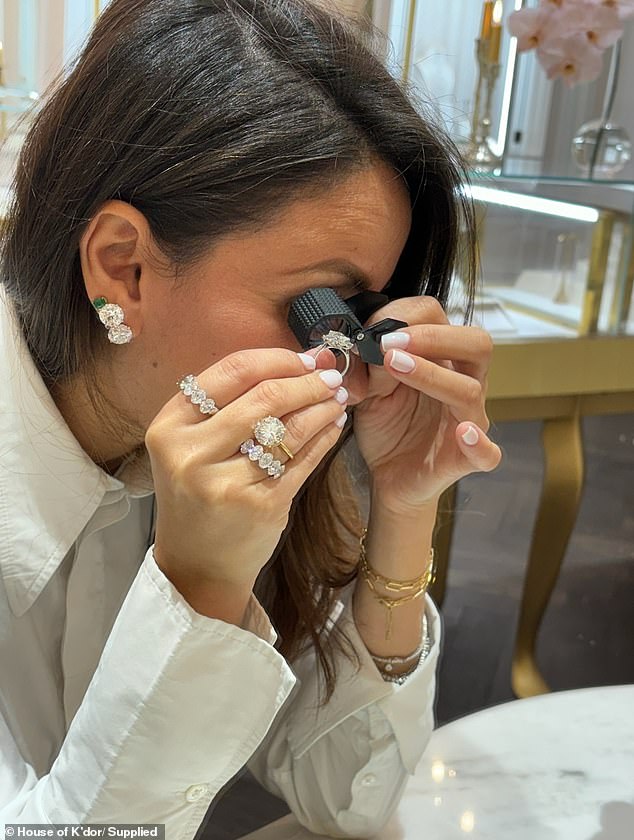Natural diamonds or ones made in a lab? Leading jewellers’ war of words over the beloved gem – and whether THEY can tell the difference
Diamond lovers are often pitted against each other when it comes to purchasing lab-grown diamonds versus natural stones mined from the earth.
Although most people struggle to tell the difference between the gemstones, their reputation in the wider society is heavily debated.
FEMAIL spoke to Australian experts Zena K’dor of natural diamond merchant House of K’dor and Rebecca Klodinsky, co-founder of laboratory diamond jeweler The Prestwick Place.
And they have very different views.
Ms Klodinsky said there is no excuse for wearing ‘bloody’ earth diamonds that are ‘wreaking havoc on the environment’ because ‘we know better’ in the wake of the climate crisis.
But Ms. K’dor claims that “nothing can replace the real thing” and that “earth diamonds are important for people who care about their appearance more than just looks.”
Laboratory diamonds in Australia are typically 70 percent cheaper than mined diamonds, with celebrities such as Taylor Swift, Jennifer Lopez, Hailey Bieber and Meghan Markle choosing the more cost-effective and sustainable route.
But some people are completely turned off: “If my boyfriend asked me to marry him with a lab diamond, I would refuse,” said one woman online in a thread about engagement rings. “They’re actually fantasy jewelry.”

Australian experts Zena K’dor of natural diamond merchant House of K’dor and Rebecca Klodinsky, co-founder of laboratory diamond jeweler The Prestwick Place shared their thoughts on diamonds
What is the biggest difference between natural diamonds and laboratory diamonds?
Ms K’dor claimed the stones were ‘completely different products’ due to their production method.
For synthetic gemstones, a diamond seed is exposed to extreme heat of more than 1,000 degrees Celsius and enormous pressure, approximately 1.5 million pounds per square inch.
A seed is created by artificially mimicking the natural processes that create a diamond, using the high-pressure, high-temperature environment, before being encased in pure carbon.
The carbon then melts and forms a diamond around the seed. Once it has cooled, the diamond is fully formed.
Ms K’dor said: ‘Natural diamonds are created in the Earth’s crust over millions of years and develop unique characteristics such as inclusions, fluorescence and shapes.
‘Lab-grown diamonds are recreated on a large scale in a laboratory to mimic the composition and appearance of natural diamonds, using technology and cubic pressing machines that can vary widely in quality.
‘There is only one machine that produces natural diamonds and that is Mother Nature, nothing else comes close.’
On the other hand, Ms. Klodinsky took a more practical approach: “The main and only difference between the two is the price.
‘Dirt diamonds have a price tag that is almost 60 percent higher than laboratory diamonds, which is due to extraction costs, mining techniques, river diversions and environmental disruptions.’

Laboratory diamonds in Australia are typically 70 percent cheaper than mined diamonds

Ms K’dor said: ‘Natural diamonds are created in the Earth’s crust over millions of years and develop unique characteristics such as inclusions, fluorescence and shapes’
Do experts prefer laboratory diamonds or mined diamonds?
For Ms. Klodinsky, laboratory diamonds are the future. She claims there is ‘no excuse’.
“As technology makes everything more accessible and consumers are more informed than ever, people are coming to this reality.
‘Sustainability is now paramount and there is no longer any need (or excuse) to buy a dirt diamond.
‘The impact of extraction and mining is too bloody and damaging, and laboratory diamonds offer a much better alternative. While dirt diamonds may have historically been the bread and butter of many jewelers, there is little need for them in today’s society.”

Ms. K’dor is fascinated by the ‘romantic story’ behind the creation of natural diamonds
But Mrs. K’dor couldn’t agree more.
‘I am personally fascinated by the romantic story that accompanies natural diamonds formed over billions of years in the womb of Mother Nature, so pure, so real, so rare that nothing is more brilliant, beautiful or dazzling than a natural diamond.
‘When you look at a diamond through a loop, you get lost in their unique properties and their ability to reflect light; no two diamonds are the same.
“At K’dor, we passionately believe in creating jewelry masterpieces with natural diamonds, because there is nothing more meaningful to give or receive. Often passed down from generation to generation as valuable heirlooms, an authentic emotional bond is created through the energy of the diamond.’
What are the misconceptions about laboratory diamonds?
Many people think that laboratory diamonds are easier to insure because they can be recreated, but that is not the truth.
“Like a fingerprint, it is not possible to recreate a laboratory diamond,” Ms. Klondinsky said.
“Lab diamonds are unique, just like dirt diamonds – they cannot be recreated and insured like a dirt diamond.”

Natural diamonds are becoming increasingly controversial as consumers worry about ethical sourcing and damage to the environment during the extraction process
Do laboratory diamonds have the same value as natural diamonds in today’s market?
When it comes to diamonds – especially when it comes to engagement rings – people should focus on personal preferences and not on the resale value of the gemstone.
Ms. Klondinsky said that while both types of diamonds have the same value in today’s market, “neither should be considered a financial asset.”
However, Ms K’dor pointed out that the supply of mined diamonds is limited, which could further increase their value.
“We have already seen a decline in the supply of natural diamonds and as a result, good quality natural diamonds are commanding premium prices with fewer options to choose from.”
Ask an expert: Would you wear a lab diamond?
Ms. K’dor is all-in for natural stone and her company was founded out of a ‘love of working with the best natural diamonds in the world’.
She said: ‘While there will always be a desire to influence consumer attitudes, I think it comes down to the individual value proposition.
‘If you are looking for a genuine, artisanal product and are looking for an authentic luxury piece that will stand the test of time, then you care about the quality and provenance of what you buy.
‘However, if you are only interested in the appearance of something, you may be attracted to products that mimic reality and are mass-produced. There is a reason natural diamonds have held their place for thousands of years.”

Ms. K’dor is all-in for natural stone and her company was founded out of a ‘love of working with the best natural diamonds in the world’
Ask an expert: Would you wear a natural diamond?
Natural diamonds are becoming increasingly controversial as consumers worry about ethical sourcing and damage to the environment during the extraction process.
“I would never wear a mined diamond,” Ms. Klondinsky said. ‘When you know better, you have to do better. There is no room at the table for dirt diamonds anymore.
‘Lab diamonds are undeniably the superior choice. They offer the same stunning beauty as dirt diamonds without environmental damage or ethical concerns.
‘Prominent figures such as Jennifer Lopez, Lady Gaga, Justin Bieber and Meghan Markle have embraced laboratory diamonds, indicating that luxury and sustainability can coexist.
“Their choice reflects a growing consensus: laboratory diamonds are the future of fine jewelry.”
Shoppers fired at each other online, with thousands taking part in the debate.
“If I can’t get a natural diamond, I’d go for a white sapphire or another gemstone,” said one. ‘
Just because something looks the same doesn’t mean it is. Laboratory diamonds are worth as much as glass.’
“I worked hard for my money and I want something that has value, that’s why I buy natural,” said another.
“Try to sell a lab diamond, people will pay you pennies.”
“People who buy natural diamonds have been brainwashed by an industry to be materialistic and spend too much money for no reason,” another argued.
‘Choosing natural diamonds unmistakably means having blood on my hands. This is just my perspective and it would drive me crazy,” one woman wrote.
